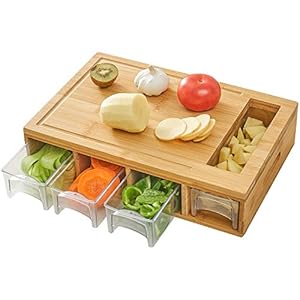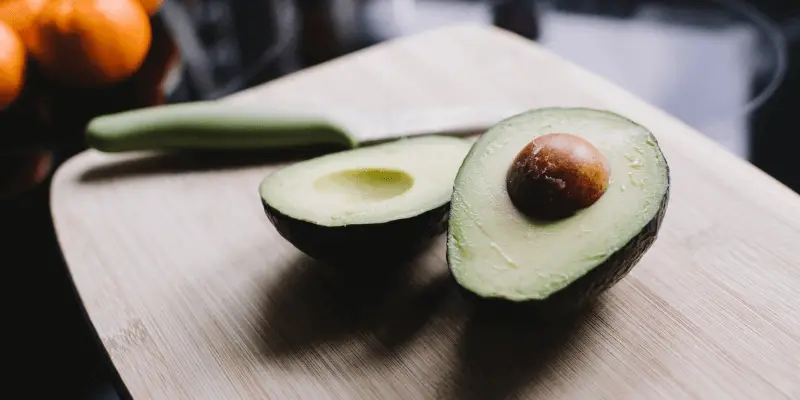Most of the bamboo cutting boards available for use in the kitchen will absorb moisture, which will make them warp.
Hence it is recommended that the buyer of the cutting board should oil it before using it for the first time, to prevent or reduce the absorption of water.
For this, mineral oil, or other oil safe for food use, should be applied to the entire surface of the cutting board, so that the oil will be absorbed by the cutting board.
To allow the oil to saturate the cutting board, it should remain soaked in oil for at least 24 hours. The board should then be washed and can be used for cutting.
How to Oil a Bamboo Cutting Board?
Since the cutting board will be used in your kitchen, you should ensure that the mineral oil used is food safe. In some cases, the oil can be mixed with butter, to reduce the seasoning time.
If food-safe mineral oil is not available for seasoning the cutting board, coconut oil is a great substitute. The oil or other mixture will form a water-repellent protective layer on the cutting board.
Avoid using cooking oils, since most of the other oils will oxidize, and the board will have an unpleasant smell.
Step 1:
Before applying oil on the cutting board, it should be washed to remove any dirt. It should then be wiped using a towel and then air-dried.
Step 2:
To treat the cutting board a clean cloth is required. The cloth should be dipped in the oil and applied to the entire surface of the cutting board including the top, bottom, and sides.
Step 3:
The oil should be applied liberally on the surface so that the entire surface is properly covered completely. Rub the oil on the surface, so that the entire surface will absorb the oil.
Step 4:
After the oil is applied for ten minutes, the excess oil from the surface can be removed. To ensure that the oil is absorbed properly, the oiled cutting board should be placed on a rack for at least 24 hours.
Step 5:
To check if the cutting board is properly oiled, some water should be placed on the cutting board. If the board is oiled properly, the water will remain, it will not get absorbed
-

Extra Large Wooden Cutting Boards for Kitchen Meal Prep & Serving – Bamboo Wood Cutting Board with Deep Juice Groove – Charcuterie & Chopping Butcher Block for Meat – Gadgets Gift (XL 18×12″)
-

NOVAYEAH Bamboo Cutting Board with 4 Containers, Large Chopping Board with Juice Grooves, Easy-grip Handles & Food Sliding Opening, Carving Board with Trays for Food Storage, Transport and Cleanup
-

Vietnam Saigoncook Round Natural Bamboo Chopping Board 10.6 Inches x 10.6 Inches x 0.6 Inches Eco Friendly Round Wooden Chopping Boards for Meat & Vegetables (1)
How Often Should You Treat a Bamboo Cutting Board?
You should be aware that the oil will be slowly lost from the top layer when the cutting board is used for cutting and washed repeatedly.
Depending on how often the cutting board is used, it may be necessary to oil the cutting board, periodically after three weeks or more so that it does not absorb water.
Why Should You Treat a Cutting Board?
The bamboo used in the cutting board is like wood in its physical properties. If it absorbs more water, it will get warped along the glue lines and disintegrate faster.
Additionally, when the bamboo is absorbing water or moisture, the top surface will become softer, due to which it will get scratched or cut more easily. Dirt and microbes often get embedded in the scratches on the surface.
Do Bamboo Cutting Boards Dull Knives Faster than Traditional Cutting Boards?
A common question being asked around our community is, do bamboo cutting boards blunt knives faster than wooden or plastic chopping blocks?
Since I regularly use both bamboo and a wooden board, I’ve noticed the negative impact on my kitchen tools, and I believe bamboo does a little more damage.
Read my article about bamboo and kitchen knives here to find out more about the subject.
Bamboo Group is a collaboration of individuals who love the world’s most sustainable and eco-friendly natural material. We believe every home can benefit from the natural colors and patterns of bamboo. We’re excited to see bamboo grow in popularity and get the recognition it deserves. Years of experience growing bamboo plants have taught us a lot we want to share with the world.




